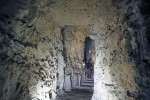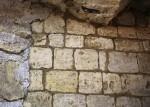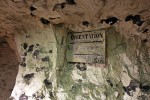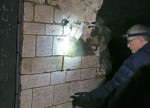 Starting in the 3rd century with the Romans, chalk was quarried from the limestone of the Picard plateau underneath the northern French town of Naours. The digging continued long after the quarrying, so much so that eventually an entire underground city was carved out of the stone, a network of man-made caves with 3 kilometers (2 miles) of roads, 300 rooms, piazzas, three chapels, cowsheds, six chimneys and a bakery with ovens. The locals used it as hiding place during the Middle Ages and early modern era when the area was subject to an endless succession of conflicts and invasions among them the Hundred Years’ War, the peasant revolt of the Jacquerie, the Burgundian Wars, the French Wars of Religion and the Thirty Year’s War. During the upheavals of the French Revolution the Naours caves were used to smuggle contraband. As many as 3,000 people plus their livestock could take refuge in the underground city.
Starting in the 3rd century with the Romans, chalk was quarried from the limestone of the Picard plateau underneath the northern French town of Naours. The digging continued long after the quarrying, so much so that eventually an entire underground city was carved out of the stone, a network of man-made caves with 3 kilometers (2 miles) of roads, 300 rooms, piazzas, three chapels, cowsheds, six chimneys and a bakery with ovens. The locals used it as hiding place during the Middle Ages and early modern era when the area was subject to an endless succession of conflicts and invasions among them the Hundred Years’ War, the peasant revolt of the Jacquerie, the Burgundian Wars, the French Wars of Religion and the Thirty Year’s War. During the upheavals of the French Revolution the Naours caves were used to smuggle contraband. As many as 3,000 people plus their livestock could take refuge in the underground city.
 The entrance was closed off in the 19th century and the caves fell into obscurity until a local priest rediscovered the site in 1887. It became a well-known tourist attraction after that and its location 25 miles behind the front lines of the Somme must have made it a popular destination for Allied troops stationed in the area during World War I. Allied forces did use Vignacourt, just five miles to the west of the caves, as a staging area, however troops were not quartered in the Naours tunnels, nor was there a field hospital in the caves as there were in some of the other underground shelters carved out of the limestone elsewhere in Picardy.
The entrance was closed off in the 19th century and the caves fell into obscurity until a local priest rediscovered the site in 1887. It became a well-known tourist attraction after that and its location 25 miles behind the front lines of the Somme must have made it a popular destination for Allied troops stationed in the area during World War I. Allied forces did use Vignacourt, just five miles to the west of the caves, as a staging area, however troops were not quartered in the Naours tunnels, nor was there a field hospital in the caves as there were in some of the other underground shelters carved out of the limestone elsewhere in Picardy.
 That’s why it was such a surprise to Gilles Prilaux, an archaeologist with France’s National Institute for Preventive Archaeological Research (INRAP), when he discovered thousands of graffiti carved on the walls of the caves by World War I soldiers. Prilaux began studying the tunnel network last July as part of a three-year project to learn more about the site’s use during the Middle Ages when he found the marks of far more recent history. While soldier graffiti is plentiful in shelters like the massive 15-mile tunnel network at Arras, they were on the front lines and Allied troops actually lived there. The soldiers who left their mark in the walls of Naours were just visiting.
That’s why it was such a surprise to Gilles Prilaux, an archaeologist with France’s National Institute for Preventive Archaeological Research (INRAP), when he discovered thousands of graffiti carved on the walls of the caves by World War I soldiers. Prilaux began studying the tunnel network last July as part of a three-year project to learn more about the site’s use during the Middle Ages when he found the marks of far more recent history. While soldier graffiti is plentiful in shelters like the massive 15-mile tunnel network at Arras, they were on the front lines and Allied troops actually lived there. The soldiers who left their mark in the walls of Naours were just visiting.
 Texan photographer and doctor Jeffrey Gusky started documenting the graffiti last December. By his tally, there are almost 2,000 names etched into the walls: 731 Australians, 339 British, 55 Americans, a few French and Canadians and 662 others of unknown nationality for a total of 1,821. Chichester University historian Ross Wilson notes that the extraordinary density of graffiti in the Naours caves give them “one of the highest concentrations on inscriptions on the Western Front.”
Texan photographer and doctor Jeffrey Gusky started documenting the graffiti last December. By his tally, there are almost 2,000 names etched into the walls: 731 Australians, 339 British, 55 Americans, a few French and Canadians and 662 others of unknown nationality for a total of 1,821. Chichester University historian Ross Wilson notes that the extraordinary density of graffiti in the Naours caves give them “one of the highest concentrations on inscriptions on the Western Front.”
Prilaux thinks that the young soldiers from distant countries would have heard about the famous “Naours caves” and taken advantage of a break from war to do some sight-seeing.
That idea is backed by an entry in the diary of Wilfred Joseph Allan Allsop, a 23-year-old private from Sydney, Australia. “At 1 p.m. 10 of us went to the famous Caves near Naours where refugees used to hide in times of Invasion” Allsop wrote on Jan. 2, 1917. […]
One of the most moving inscriptions at Naours was made by Herbert John Leach, a 25-year-old from Adelaide. His inscription reads “HJ Leach. Merely a private. 13/7/16. SA Australia.”
Barely a month after Leach added his name to the wall he was killed in action on Aug. 23, 1916, during the Battle of Pozieres.
On his grave, in the Australian cemetery in nearby Flers, his father inscribed “Duty Nobly Done.”
Any names lists out there?
Not yet, I’m afraid, but I’ll see if I can find one.
Agree, would love to find out the names, heading over there in August. Only found out about the caves this morning.
Was there something in National Geographic not long ago about some similar caves? I believe they are on private property, and not open to the general public.
Yes there was, and Jeff Gusky photographed them too. Apparently all of Picardy is a thin layer of soil atop vast warrens carved out of the limestone plateau.
Very interesting!
And if they made a list of the names, it would be a nice addition to the usual tales of WWI soldiers. This is where some chose to go on a rare day off… In a way, that’s much more personal than where they fought.
Also, I think it would make a nice subject for a article by some student of history, archeology or conservation studies: What has to happen for graffiti to go from being just damage to being another layer of history?
Not to get too historiographical about it, but I think all it takes for graffiti to go from vandalism to history is for someone to treat it that way. I remember in college there was a very popular pamphlet series discussing campus bathroom graffiti as discourse, and that was all recent writing. Some graffiti was probably instantly historic, like when Lord Byron carved his name into the walls of the Temple of Poseidon at Sounion Point in Greece.
Now that you mention it, though, I’m curious when the graffiti at Pompeii, subject of so many scholarly studies today, began to be treated as historically significant. I’m going to have to look into that.
I am thought provoked by Lauriana’s comment!
What saddened me about this post, is that humans never cease find something to fight and kill each other over. Century after century, it is always the same..just with more advanced weapons. We need more advanced humans.
Hi wonderful for anyone who finds a family member! My grandad was Alfred Williamson from Salford. Would love for him to have written something here. He. Survived the war somehow! Colin Barrick